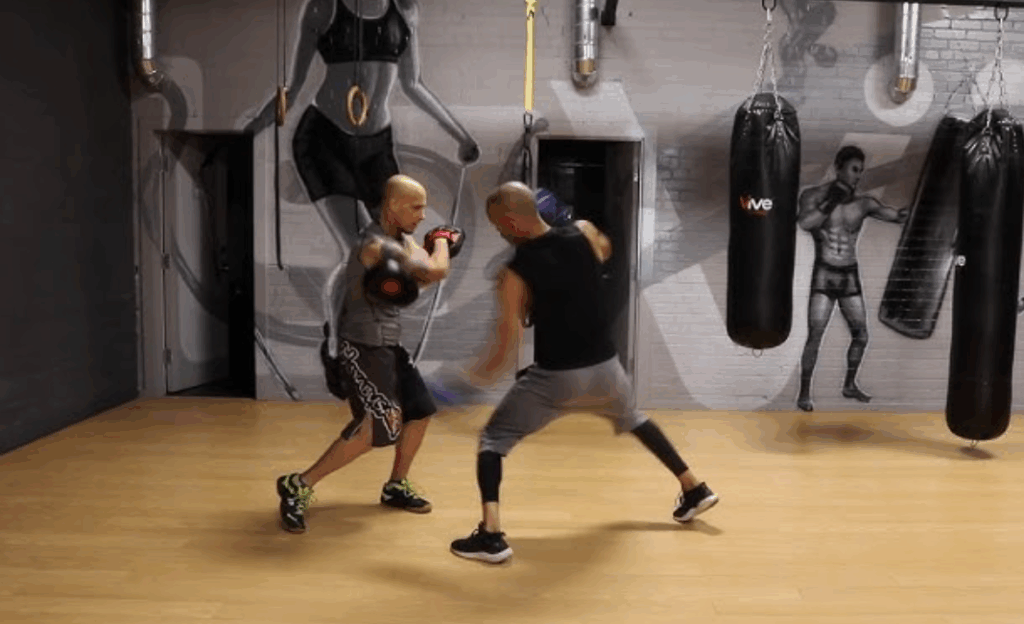Learning boxing pivots involves proper weight transfer from one foot to the other while keeping your spine straight and your core engaged. Focus on your axis point with the ball of your pivoting foot and then generate power with your legs and hips. Try “clock drill” and “pivot-and-punch” drills. Over-rotating or dropping your guard during pivots are common mistakes.
The perfect pivot combines defensive movement with immediate counterattack positioning for devastating angle advantages that your opponents won’t see coming.
Weight Transfer and Body Mechanics
The foundation of effective pivoting lies in mastering weight transfer and proper body mechanics. When you pivot, your weight distribution should shift smoothly from one foot to the other while maintaining perfect balance throughout the rotation. Your feet serve as your base, with the ball of your pivoting foot acting as the axis point.
A proper alignment is key. Keep a straight spine and engaged core as you turn. Your legs and hips provide the power, not your upper body. Keep your knees slightly bent during footwork technique.
Remember that efficient pivoting feels seamless, not forced or mechanical. Your upper body rotation should follow naturally from the movement initiated by your feet.

Key Drills to Develop Your Pivoting Technique
Now that you understand the mechanics behind effective pivoting, let’s focus on practical drills that will transform your theoretical knowledge into muscle memory. Start with the “clock drill.” Position yourself in the center of an imaginary clock and practice pivoting to different hour positions while maintaining proper defensive movement.
Next, try the “pivot-and-punch” exercise where you pivot on your lead foot while throwing a hook, enhancing both coordination and punching power. For developing offensive angles, work with a partner who applies light pressure as you pivot away and counter.
The “pivot ladder” is another effective drill. Place markers in a ladder formation and practice pivoting between them while throwing combinations, gradually increasing your speed as technique improves.
Common Pivoting Mistakes and How to Fix Them
Despite mastering various drills, many boxers still struggle with fundamental pivoting errors that compromise their effectiveness in the ring. The most common pivoting mistakes include over-rotating, which disrupts your balance and leaves you vulnerable to counters.
You’ll often see fighters dropping their guard during pivots, creating dangerous openings. Fix this by consciously maintaining hand position throughout your rotation. Another error is pivoting without purpose. Each pivot should set up either an offensive opportunity or a defensive slip.
Many boxers also pivot with flat feet rather than pushing off the ball of the foot, robbing them of the explosiveness needed for effective counterpunching. Practice proper weight transfer by rising slightly as you pivot, ensuring your weight remains centered for ideal stability and power generation.

Strategic Applications of Pivoting in Offensive Combinations
Once you’ve eliminated these common mistakes from your pivoting technique, you’re ready to integrate this footwork into dynamic offensive sequences. The boxing pivot becomes most lethal when chained with punches that capitalize on your new angles and positioning.
Try a jab-cross followed by a step pivot to your left, setting up a powerful hook as your opponent turns to face you. It creates leverage that your straight punches alone couldn’t generate. Or use a quick front-foot pivot after throwing a body shot to slide outside your opponent’s lead foot, giving you perfect stance control for follow-up combinations.
Remember that pivoting isn’t just about evasion. It’s about creating opportunities. When executed properly, your pivot should simultaneously move you to safety while positioning you for immediate counterattacks.

Defensive Pivoting: Creating Angles to Evade and Counter
While offensive pivoting puts you in a position to launch attacks, defensive pivoting serves as your shield against incoming punches while simultaneously setting up counter opportunities. When an opponent throws a straight punch, pivot off your back foot to create a new angle that leaves them punching air while improving your ring positioning.
The key is timing your pivot with a subtle feint to disguise your movement. As your opponent commits to their attack, shift your weight and rotate away from the punch’s path. It creates a perfect position to launch counters from angles your opponent can’t easily defend.
Remember to maintain your guard throughout the pivot. Many fighters drop their hands during defensive movements, creating dangerous openings that skilled opponents will exploit.
Frequently Asked Questions
Can Pivoting Techniques Vary Based on Fighting Style?
Yes, your pivoting techniques will naturally vary based on your fighting style. Aggressive fighters use offensive pivots, counter-punchers favor defensive pivots, and mobile boxers rely on step pivots for angular movement.
How Long Does It Take to Master Pivoting Skills?
It typically takes 3-6 months of consistent practice to develop proficient pivoting skills. You’ll notice improvement within weeks, but mastery requires regular drilling and application in sparring sessions over longer periods.
Should Southpaw Boxers Pivot Differently Than Orthodox Fighters?
Yes, you’ll pivot in mirror-image patterns. As a southpaw, you’ll rotate clockwise when orthodox fighters rotate counterclockwise. The mechanics remain identical, but do reverse directional movements to maintain the same tactical advantages.
Can Poor Pivoting Contribute to Knee Injuries?
Yes, poor pivoting can damage your knees. When you rotate incorrectly, you’ll put excessive strain on your knee ligaments. Always pivot on the ball of your foot with proper weight distribution to stay injury-free.
How Do Professional Boxers Use Pivoting Differently Than Amateurs?
Pros use pivots more subtly and efficiently than amateurs. You’ll notice they integrate pivoting seamlessly with combinations, create better angles, and maintain perfect balance while generating maximum power through refined hip rotation.




